2021. June 24.
The patent-pending smart nanofibre mask, developed by BME’s researchers, not only filters the air effectively, but also monitors the wearer’s breathing.
“One and a half years ago there were only snippets of news arriving from Asia about the coronavirus which has since become a global pandemic. This is when I started my new research project, which I initially just hoped would provide protection for people at times like this. Although my research is far from complete, we are on the right track”, He Haijun, a Chinese PhD student at the Department of Polymer Engineering of BME’s Faculty of Mechanical Engineering said. His pioneering research is supported by his mentor, Kolos Molnár, senior lecturer of the department. The student has invented a breathable, smart mask filter based on triboelectric nanogenerators (TENG) for respiration monitoring. (Triboelectric nanogenerator (TENG) is a newly developed energy-harvesting technology that can convert ubiquitous mechanical energy into precious electricity based on the coupling effect of contact electrification and electrostatic induction – editor). The young researcher was awarded joint first prize at the university’s 2020 “BMe Research Grant”, which was launched to present prominent research areas via the internet.
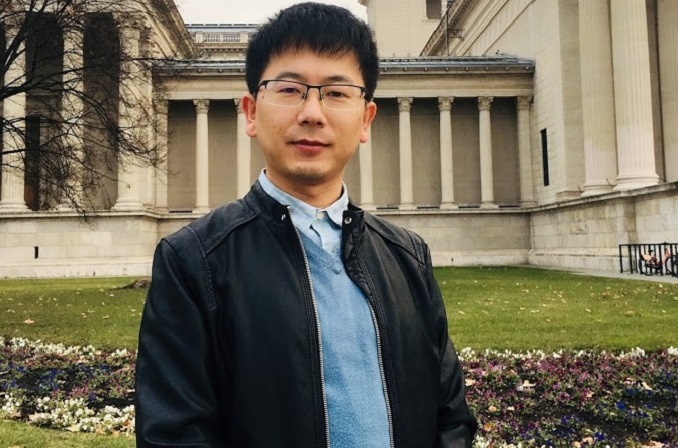
|
The "BMe Research Grant" was introduced in 2010 at the initiative of Professor György Mihály, head of the Habilitation Committee and Doctoral Council of the University (EHBDT) at the time. Since then the university’s young researchers have had the opportunity to submit their ideas for evaluation every year. By announcing the grant, EHBDT wishes to publish research results in an easily understandable way to a wider audience on the University’s website, thus successfully showcasing BME’s scientific and technological potential. Its further aim is to disseminate results to a wider audience in Hungary and promote outstanding scientific research findings both nationally and internationally. The grant is available to doctoral students under the age of 35 who have not yet earned their PhD degree at the time of application. Individual entries may be submitted with the approval and written recommendation of their supervisor. The key criteria during evaluation include the scientific, technical and artistic value, the standard and clarity of the composition of the work, as well as its expected or already realised scientific impact. Over the past 10 years the Reviewing Committee has had the enjoyable, but difficult task of selecting the best entries from the applications which are generally characterised by a high standard”, László Nyulászi, head of the EHBDT explained. He stressed that the details of the Call for the 2021 BMe Research Grant, available for doctoral students, are being finalised, but the contents are the same as last year’s. The deadline for applications is: 5 July 2021. The list of the 2020 BMe Research Grant winners is available here. |
There are various-sized aerosol particles in the air, including viruses, bacterial cells, fungal spores, fragments, and pollen grains, which may cause health issues, especially infectious diseases if they penetrate the human respiratory system. The diameter of the 2019-novel coronavirus (nCoV) particles varies from about 60 to 140 nm, however, correctly worn surgical masks made of melt-blown microfibres can prevent the transmission of human CoVs from symptomatic to healthy individuals. He Haijun started to research how nanofibres can be used as a mask filter at the outbreak of COVID-19 in Asia, well before the introduction of strict epidemiological measures in Europe. He realised that nanofibres had demonstrated huge prospects in creating high-performance air filters, multifunctional devices and even masks used by the general public.
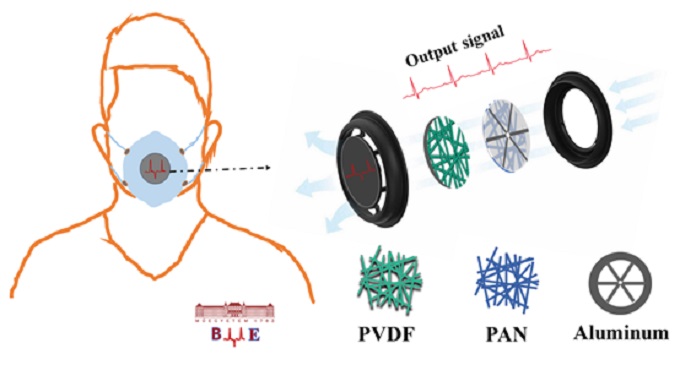
The structure of the smart mask filter
“Nanofibres have reduced diameters and excellent mechanical properties. They allow for scalable preparation from various raw materials and the electrospun nanofiber web is an excellent alternative candidate to replace melt-blown fibres as a filtration media because of its small pore size and large specific surface area”, the grant awardee explained regarding the details of his research. His long-term aim is to develop an easy-to-use and comfortable mask with a self-powered smart sensor, which not only has high filtration efficiency, but is also capable of monitoring respiration and can be used as an important indicator of human health. Instead of a traditional filter, the mask would be fitted with a TENG sensor, supported by artificial intelligence and capable of monitoring the wearer’s breathing, while the material of the mask would be able to filtrate airborne nanosized particles, due to its large specific surface area, high porosity and small pore size. Respiratory rate is a vital sign used to monitor the progression and severity of certain illnesses. “Combining a respiratory rate monitoring system with a mask can be a convenient way of detecting the respiratory condition of patients infected by Covid-19”, He Haijun said, summing up his work, adding that there has been little research focused on developing masks that can be used as a filter and a respiration monitoring system simultaneously.
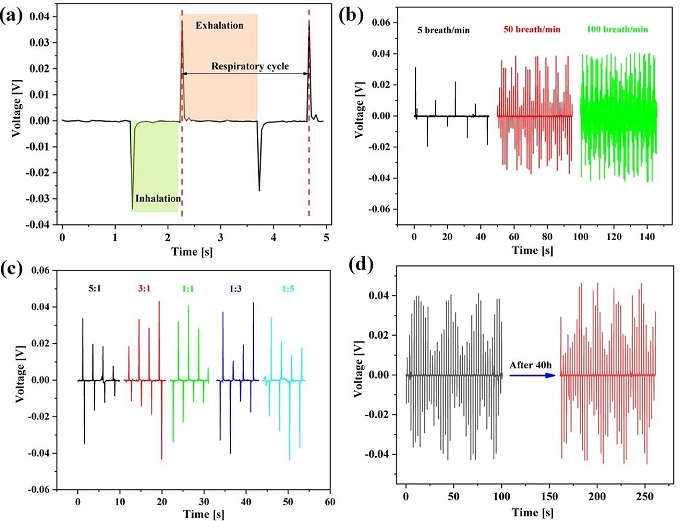
The output voltage of the TENGs according to different breathing parameters: (a) characterisation of one respiratory cycle, (b) different respiratory frequencies, (c) different quotients (the ratio of inhalation and exhalation), (d) the durability of the TENG .
The young researcher wants to optimise the TENG configuration to eliminate the disturbances caused by noise, and generate stable and measurable voltage signals based on the respiratory parameters. The output voltage signals are then analysed to evaluate the respiratory state and the health status of the wearer. He Haijun is currently working on stabilising the voltage output. Once achieved, the device can be used as a smart mask filter. He also compared the filtration efficiency of his mask with the KN95/FFP2 masks, currently used for protection against the virus. The filtering efficiency of his newly developed mask was 98% of that achieved by the above masks. Apart from analysing the material, the researcher also developed a new and effective electrospinning method, utilising the Weissenberg effect, to avoid needle clogging. He named it rod-climbing electrospinning (RC-ES), for which he developed and built his own device. The advantage of this method is that the nanofibres to be used in the masks can be produced from relatively viscous polymer solutions, which cannot be electrospun with traditional electrospinning. His proposed final product will be a mask for the everyday user, capable of detecting the deformation of nanofibre membranes caused by the wearer’s breathing, and using wireless data transfer to detect relatively large and fast changes in the respiration rate, as well as the inhalation and exhalation time. During He Haijun’s experiment a human breathing process was simulated and electrical signals were recorded, using a ventilator with controllable respiratory parameters developed by BME’s researchers. The smart mask is being developed through inter-faculty cooperation, with the involvement of PhD student Guo Jian (Department of Control Engineering and Information Technology, BME’s Faculty of Electrical Engineering and Informatics), who is responsible for testing the sensor and developing the electric circuit.
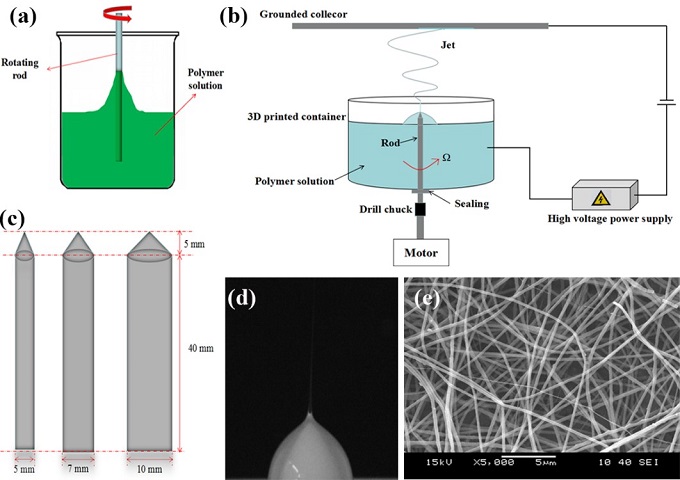
(a) Schematics of the Weissenberg effect (rod-climbing), (b) schematic drawing of the rod-climbing electrospinning (RCES), (c) rods used for electrospinning, (d) optical image of the meniscus in the electrospinning process, (e) SEM image of nanofibres produced by RCES.
The new method, developed by BME’s student is completely unique. He has already applied for a patent, supported by BME’s Centre for University-Industry Cooperation (FIEK) which is currently pending. The first prototype of the smart mask is already available. Researchers from BME’s Faculty of Electrical Engineering and Informatics are helping to produce the next prototype, which is expected to have wireless data transmission capability. The researchers are also working on a mobile phone application for monitoring and analysing respiratory information, and sending a warning to the user or their physician in case of health problems.
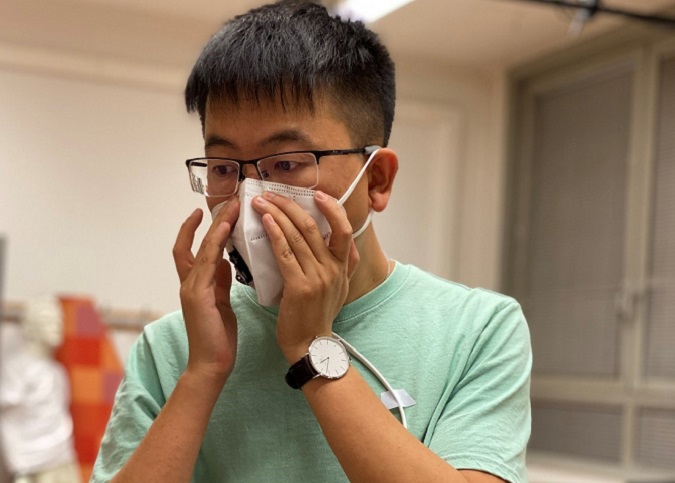
“I am truly honoured to receive this prize, awarded to me by prominent Hungarian professionals. Such an acknowledgement confirms that I am on the right track in my research and all the hard work was worth it. It is a great motivation for me to continue my research to develop a device which can make life easier for many people”, the PhD student explains. He graduated in textile engineering in China, then came to Hungary to start his doctoral studies with the help of a bilateral scholarship programme between the governments of Hungary and China. “I was attracted to BME by the superb scholarship programme, an excellent mentor and a new research topic”, the young awardee explained. Apart from scientific research, he is happily involved in teaching: he holds lab practice for BSc and MSc students, and also helps them prepare their theses and TDK papers. “My teachers are my role models; they were instrumental in strengthening my commitment towards engineering and in becoming who I am today. I would like to pass on this attitude to the next generation”, He Haijun said in his closing remarks at the end of his interview with bme.hu.
|
|
TZS-HA
Photos by: He Haijun, Kolos Molnár



